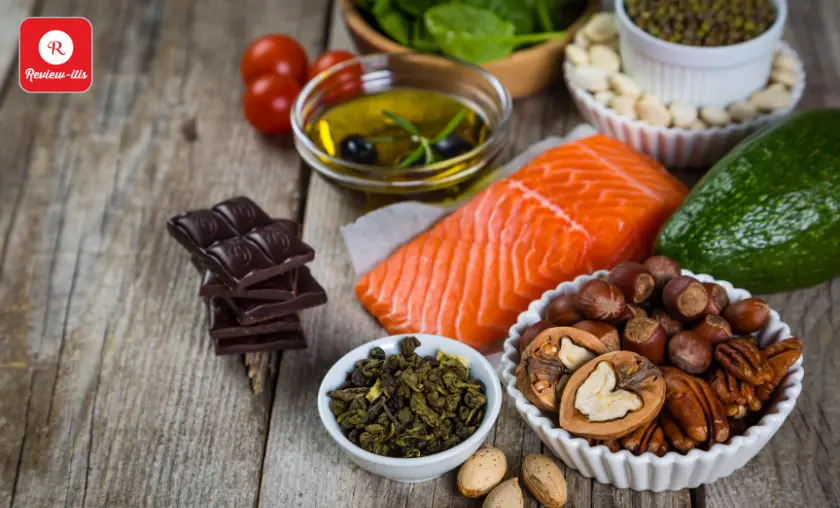Welcome to “Healthy Eating Habits” This comprehensive guide will explore key principles and practical strategies for developing and maintaining healthy eating habits. From understanding the components of a balanced diet to navigating dining out, managing emotional eating, and incorporating favorite foods, this guide is designed to empower you with the knowledge and tools to make informed choices and embrace a healthier lifestyle.
Table of Contents
Get ready to embark on a journey towards nourishing your body and nurturing your well-being through the power of healthy eating habits.
Healthy Eating Habits

Eating a healthy diet? It’s not about following rigid rules, striving for unattainable thinness, or depriving yourself of your favorite indulgences. No, no, my friend. It’s all about feeling absolutely fantastic, brimming with energy, enhancing your well-being, and even lifting your spirits sky-high!
Now, I understand. Navigating through the sea of contradictory nutrition and diet advice can overwhelm you. You’re not alone in this bewildering maze, believe me. Every so-called expert has the different opinion on what’s good for you and what’s not. Oh, the confusion! But let me spill the beans: it’s not about one magical food or a specific nutrient. Nope! It’s about the bigger picture—your overall dietary pattern is the true MVP here. So, let’s take back to basics, shall we? Ditch those processed goodies and embrace real, unadulterated food whenever possible. Trust me, aligning your eating habits with nature’s goodness can transform the way you think, the way you look, & the way you feel.
Now, my friend, listen closely. I’ve got a treasure trove of simple tips to share with you. They’ll slice through the fog of confusion and empower you to craft a scrumptious, diverse, and oh-so-nourishing diet that not only pleases your taste buds but also works wonders for your mind and body.
The Fundamentals of Healthy Eating

You know, there is a lot of talk about extreme diets these days, but the truth is, our bodies need a mix of protein, fat, carbs, fiber, vitamins, and minerals to stay healthy. No need to cut out whole food groups—choose the best options from each category.
- Protein is like the fuel that keeps us going, powering our energy, mood, and brain function. Although excessive protein can harm those with kidney disease, new studies indicate that many of us could benefit from more high-quality protein, especially as we get older. You do not have to rely on animal products alone—incorporating a range of plant-based protein sources into your daily meals can provide all the essential protein your body requires.
- Fat. Not all fat is created equal. Bad fats can ruin your diet and raise your risk of diseases, but good fats are like superheroes for your brain and heart. Healthy fats, like omega-3s, are essential for your physical and emotional well-being. Adding more of these good fats to your diet can enhance your mood, improve your overall health, and even help you slim down.
- Fiber. Foods rich in dietary fiber, like grains, fruits, veggies, nuts, and beans, have some incredible benefits. They can keep you regular, reduce the risk of heart disease, stroke, & diabetes, & even enhance your skin. Plus, if you’re looking to shed some pounds, fiber can be a helpful ally in your weight loss journey.
- Calcium. It’s not just about preventing osteoporosis—insufficient calcium in your diet can also impact your mental well-being, causing anxiety, depression, and sleep problems. Regardless of your age or gender, it’s crucial to include calcium-rich foods, avoid those that deplete calcium, and ensure you’re getting enough magnesium, vitamin D, and vitamin K to support calcium’s role in your body.
- Carbohydrates are a crucial energy source for your body. However, focusing on complex, unrefined carbs like vegetables, whole grains, and fruits rather than sugars and refined carbs is best. By reducing your intake of white bread, pastries, starches, and sugar, you can prevent rapid blood sugar spikes, mood swings, energy fluctuations, and unwanted fat accumulation, particularly around your waistline.
Making the Switch to a Healthy Diet

Making the switch to a healthier diet doesn’t need to be an all-or-nothing endeavor, dear. You need not strive for perfection, nor should you completely eliminate those delightful foods you enjoy. And let’s not overwhelm ourselves by attempting to change everything all at once. That approach often leads to sneaking in a cheat meal or giving up on your new eating plan.
A much wiser approach would be to introduce a few small changes gradually. By setting modest goals, you’ll find greater success in the long run without feeling deprived or swamped by a drastic diet makeover. Picture it as a series of manageable steps towards a healthier diet, my dear—perhaps start by adding a fresh salad to your daily meals. Once these small changes become habitual, you can continue to incorporate more nourishing choices into your lifestyle.
Setting Yourself Up for Success

To ensure your success, let’s keep it simple, shall we? Adopting a healthier diet doesn’t have to be a convoluted affair. Instead of fixating on calorie counting, my dear, let’s approach our meals with a focus on color, variety, and freshness. Aim to steer clear of packaged and processed foods; instead, opt for the vibrant goodness of fresh ingredients whenever you can.
- Prepare More of Your Own Meals. By cooking more often in your own kitchen, you gain the power to closely monitor what goes into your food. This means consuming fewer calories and steering clear of the chemical additives, added sugar, and unhealthy fats lurking in packaged and takeout options. Say goodbye to the fatigue, bloating, and irritability caused by such foods, which can worsen symptoms of depression, stress, and anxiety.
- Make the Right Changes. When reducing the presence of unhealthy foods in your diet, my dear, it’s crucial to replace them with wholesome alternatives. Swapping out perilous trans fats for nourishing fats (like opting for grilled salmon over fried chicken) will positively impact your well-being. However, substituting animal fats with refined carbohydrates (such as trading your breakfast bacon for a donut) will not lower your risk of heart disease or enhance your mood.
- Read the Labels. It’s crucial to remain mindful of what lurks within your food. You see, manufacturers have a sneaky tendency to conceal significant amounts of sugar or unhealthy fats within packaged products, even those that claim to be healthy. Stay vigilant and read those labels, my dear, for knowledge is your armor against hidden ingredients.
- Focus on How You Feel After Eating. You’ll nurture wholesome habits and develop a taste for healthier fare. Remember, the food quality directly impacts how you feel after a meal. Opting for nourishing options will leave you feeling energized and satisfied. Conversely, indulging in junk food is likely to leave you uncomfortable, queasy, or lacking in vitality.
- Drink Plenty of Water. Water plays a vital role in cleansing our bodies of waste and toxins. Sadly, many of us trudge through life in a state of dehydration, resulting in fatigue, diminished energy, and headaches. It’s all too easy to confuse thirst for hunger, my dear, which is why staying adequately hydrated aids in making healthier food choices.
Moderation: Important to Any Healthy Diet

Let’s talk about moderation, shall we? It entails consuming the amount of food that your body truly requires. You should feel content after a meal but not uncomfortably full. For many of us, moderation means scaling back our current portions.
However, it doesn’t imply eliminating the foods you hold dear. For instance, eating bacon for breakfast once a week can be considered moderation if followed by a nourishing lunch and dinner. But indulging in a box of donuts and a sausage pizza afterward? Well, my dear, that stretches the boundaries of moderation a tad too far.
- Try Not to Think of Certain Foods as “off-limits.” When we forbid ourselves from certain foods, our desire for them tends to intensify. And if we give in to temptation, we’re left feeling like we’ve failed. Instead, let’s begin by reducing the portion sizes of unhealthy foods and consuming them less frequently. As you gradually decrease your intake of these unhealthy choices, you may discover that your cravings diminish or that you view them as occasional treats.
- Think of Smaller Portions. Serving sizes have indeed grown out of control in recent times. When dining out, opt for a starter instead of an entree, share a dish with a friend, and resist the urge to order anything supersized. At home, allow visual cues to guide your portions. A serving of meat, fish, or chicken should match the size of a deck of cards, while half a cup of mashed potato, rice, or pasta resembles a traditional light bulb. Using smaller plates or bowls can trick your brain into perceiving larger portions.
- Take Your Time. Let’s take a moment to appreciate food as nourishment rather than a mere on-the-go necessity between meetings or errands. You see, it takes a few minutes for your brain to signal satiety to your body. That’s why eating slowly and pausing before feeling overly full is vital. You’ll cultivate a healthier relationship with food by savoring each bite and giving yourself time to register satisfaction.
- Eat With Others Whenever Possible. When you find yourself dining alone, particularly in front of the TV or computer, it’s all too easy to fall into the trap of mindless overeating. Let us strive to bring intention and mindfulness to our meals, even when in solitude.
- Limit Snack Foods in the Home. Watch out for the foods you have within reach. Eating in moderation is harder when you have unhealthy snacks readily available. Instead, surround yourself with healthy options. And when you want to indulge in a treat, make a deliberate trip to get it.
- Control Emotional Eating. Eating is about more than just satisfying hunger. Sometimes we rely on food to cope with stress or negative emotions like sadness, loneliness, or boredom. However, by discovering healthier ways to handle stress & emotions, you can regain control over your eating habits and feelings.
It is Not Just What You Eat but When You Eat

Remember, a well-rounded diet is essential for success. So, here’s a pro tip: kickstart your day with a nourishing breakfast that’ll give you the energy boost you need!
You see, a healthy breakfast isn’t just about filling your belly. It actually jumpstarts your metabolism, getting it revved up and ready to tackle the challenges of the day. But that’s not all, my friends. Enjoying smaller yet nutrient-packed meals at regular intervals is crucial to maintain those high energy levels throughout the day.
Here’s Another Tip for You: avoid munching during those late-night gaming sessions. Instead, consider shifting your dinner time a bit earlier and embracing a fasting period of around 14-16 hours until breakfast the next morning. Trust me, the research is in, and it suggests that aligning your eating habits with your most active hours and giving your digestive system a substantial daily break can actually help you regulate your weight.
Add More Fruit & Vegetables to Your Diet

Fruits & vegetables are low in calories & rich in nutrients like vitamins, minerals, antioxidants, & fiber. Aim for at least five servings per day to feel satisfied and reduce unhealthy food intake. A serving can be half a cup of raw fruit or vegetables or or banana, a small apple. Many of us need to double our current intake.
To Increase Your Intake:
- Sprinkle antioxidant-rich berries onto your breakfast cereal.
- Enjoy a variety of sweet fruits like oranges, mangos, pineapple, or grapes as a dessert.
- Substitute your regular rice or pasta with a vibrant salad as a side dish.
- Replace processed snack foods with veggies like carrots, snow peas, or cherry tomatoes paired with a zesty hummus dip or peanut butter.
How to Make Vegetables Tasty

Plain salads and steamed veggies can become dull, but there are numerous ways to add flavor to your vegetable dishes.
- Add Color. Vibrant and richly colored vegetables provide higher nutrient levels and enhance meals’ taste and visual appeal. Add bursts of color with fresh or sundried tomatoes, glazed carrots or beets, roasted red cabbage wedges, yellow squash, or sweet, colorful peppers.
- Liven Up Salad Greens. Explore beyond lettuce and try nutrient-rich greens like kale, arugula, spinach, mustard greens, broccoli, and Chinese cabbage. To enhance the taste of your salad, experiment with drizzling olive oil, using a spicy dressing, or adding toppings like almond slices, chickpeas, a hint of bacon, parmesan, or goat cheese.
- Satisfy Your Sweet Tooth. Enjoy the natural sweetness of vegetables like carrots, beets, sweet potatoes, yams, onions, bell peppers, and squash to satisfy your cravings for added sugar. Incorporate them into soups, stews, or pasta sauces for a delightful and satisfying touch of sweetness.
- Broccoli, Cooked Green Beans, Brussels Sprouts, and Asparagus in New Ways. Rather than boiling or steaming these nutritious sides, explore grilling, roasting, or pan-frying them with chili flakes, garlic, shallots, mushrooms, or onion for added flavor. Alternatively, marinate them in tangy lemon or lime before cooking.
Conclusion
Adopting healthy eating habits can greatly contribute to your overall well-being. By incorporating nutrient-dense fruits and vegetables, diversifying your meals with colorful and flavorful options, and exploring different cooking methods, you can create a balanced and enjoyable eating experience. Remember to be mindful of portion sizes & consider the timing of your meals.
With these practical tips and a commitment to making positive choices, you can embark on a journey toward a healthier lifestyle. Remember, small changes can make a big difference in the long run. Cheers to embracing healthy eating habits for a happier and more vibrant life!
FAQs
Is It Necessary to Count Calories to Maintain a Healthy Diet?
Counting calories is optional for everyone. Instead, focus on listening to your body’s hunger and fullness cues, making balanced food choices, and practicing portion control. Prioritize the quality of your food by opting for nutrient-dense options and being mindful of portion sizes.
What Are Some Practical Ways to Overcome Emotional Eating?
Identifying triggers and finding alternative coping mechanisms to overcome emotional eating is important. Engage in stress-relieving activities like exercise, meditation, or journaling. Seek support from friends, family, or a therapist. Practice mindful eating by paying attention to your emotions and the physical sensations of hunger and fullness.
Can I Still Enjoy My Favorite Foods While Following a Healthy Eating Plan?
Absolutely! Incorporating your favorite foods in moderation is key to maintaining a sustainable healthy eating plan. Practice portion control, balance indulgences with nutrient-rich meals, and savor the flavors mindfully. Flexibility and moderation are crucial for long-term success.
How Can I Ensure I’m Getting Enough Nutrients on a Plant-based Diet?
A plant-based diet can provide all the necessary nutrients with careful planning. Include a variety of vegetables, fruits, whole grains, legumes, nuts, and seeds. Consider supplementation for nutrients that may be lacking, such as vitamin B12. Consulting with a registered dietitian can also help create a well-rounded plant-based eating plan.
Are There Specific Foods That Can Help Boost My Immune System?
A balanced diet rich in fruits, whole grains, vegetables, lean proteins, and healthy fats can support a strong immune system. Foods like citrus fruits, berries, garlic, ginger, spinach, and yogurt are known to have immune-boosting properties. However, a healthy lifestyle, including adequate sleep, regular exercise, and stress management, is crucial in maintaining a robust immune system.
For more amazing articles related to Fitness, Checkout Now with a click
To read more similar articles, click here.
Thanks for visiting our Website. If you appreciate our work, kindly show us some support in our comments section. 🙂